AJF’s Young Artist Award acknowledges promise, innovation, and individuality, advancing the careers of rising artists. The work of the winner and four finalists represents a group of outstanding pieces of contemporary jewelry. As a finalist, Csipö received an unrestricted cash award of US$1,000 and exhibited her work in Platina’s booth during Munich’s jewelry week.
AJF asked this year’s honorees to tell us about their backgrounds and their thoughts on the future of our field. This is the second of our interviews. Read the interview with the winner, Bryan Parnham, here.
The competition was open to makers of wearable art age 35 and under who are not currently enrolled in a professional training program. Judging was based on originality, depth of concept, and quality of craftsmanship. This year’s jurors were 2022 AJF Artist Award winner Mallory Weston (from the US); collector and gallerist Atty Tantivit (Thailand); and maker Ted Noten (Netherlands). Stay tuned for interviews with the other finalists over the coming months. The other finalists were Aaron Decker (US) (Decker answered our questions here), Corrina Goutos (US/Germany) (we spoke with Goutos here), and Everett Hoffman (US) (read the interview with Hoffman here). Also, watch AJF Live with Bryan Parnham here.
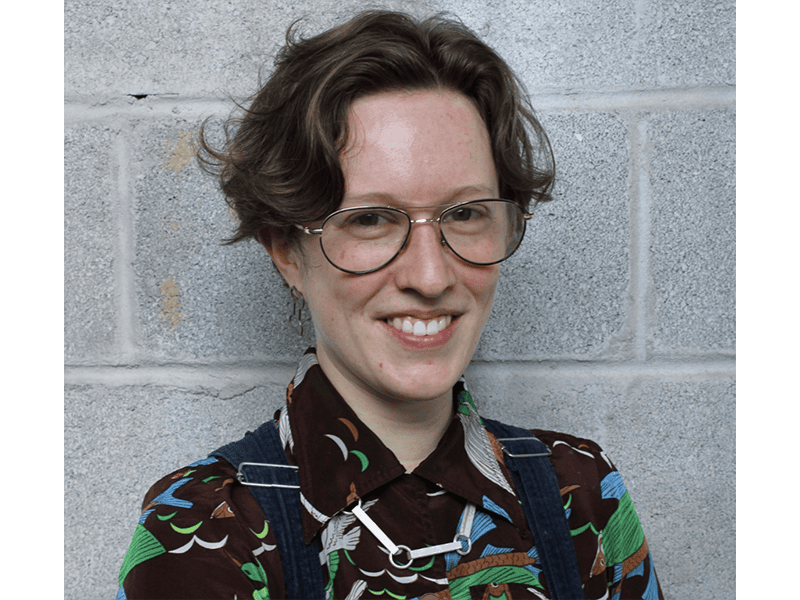
AJF: Congratulations on being a finalist for the Young Artist Award competition, Margo—that’s quite an accomplishment! How did you become interested in jewelry? And what inspires your work?
Margo Csipö: From the get-go, I’ve been transfixed by little intimate and indulgent items. As a young child, I was always reaching for anything shiny in my vicinity. This kept my parents busy fishing necklaces out of my grubby little grasp and apologizing profusely to the wearers.
I come from a very DIY crafty family, and that gave me the ridiculous idea that I can make anything if I try hard enough. A lifelong drawing habit had to find its way into my jewelry, so that’s where the combination of heavy fabrication and illustration comes from!
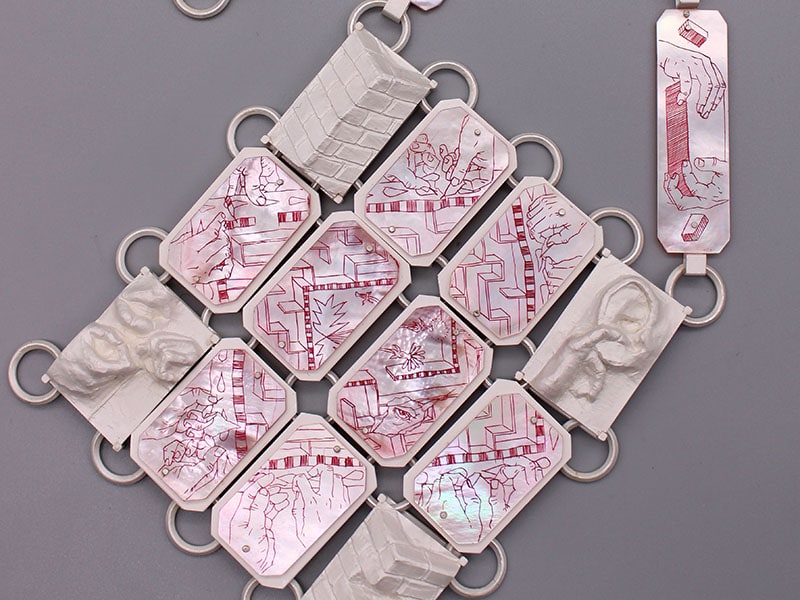
As an illustrator and writer, world-building and storytelling is intrinsic in my work. The field that most inspires me is film animation. In it, a holistic labor goes into crafting a world of narrative, image, motion, and sound, and that is something I would like to harness when making jewelry. In animation, the static image is given life when a relationship is built between other images. With the illustration in my jewelry, the relationship between the object and the body animates it. As for animators and filmmakers that I idolize, check out Yuri Norstein, Marcell Jankovics, Sergei Parajanov, and Masaaki Yuasa.

What does being a finalist mean for you? Do you think it will influence you going forward?
Margo Csipö: My BFA is not in jewelry and metalsmithing, so I’ve always felt like I was playing catch-up with my peers. Being a finalist is a reminder that hard work pays off, and that something is always worth doing if you’re truly passionate about it. Going to Munich for jewelry week gave me a chance to leave my little corner of mid-Atlantic USA and really see the field at a much larger scope. I met people I have always wanted to meet and reconnected with some great friends! I’m applying for grad schools this winter, and seeing the work coming out of institutions in Europe was exciting and inspiring—especially with materials I’ve always wanted to explore, like carved stone, amber, and glass beads.
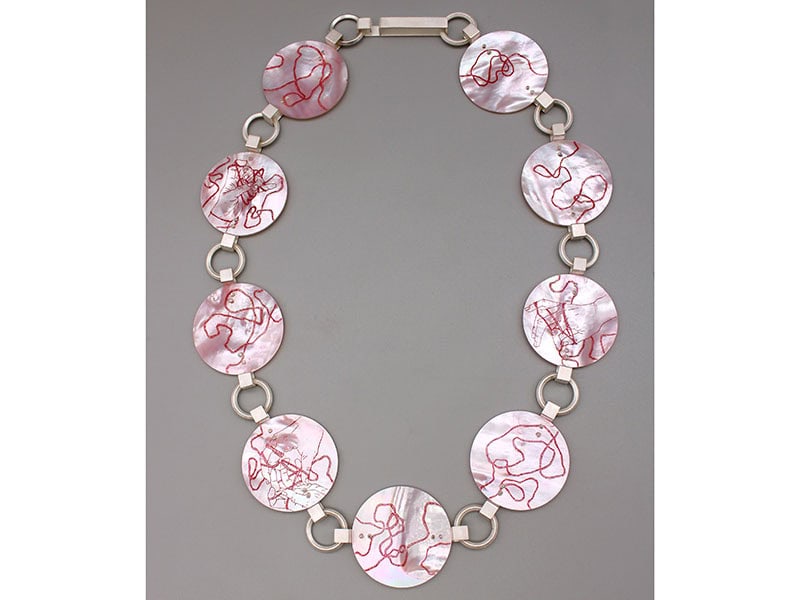
Tell us about the work you applied with.
Margo Csipö: It can be split into two bodies: necklaces and masks.
A necklace is narrative by nature. It has a sequence and a plot from the closure on one end to the closure on the other—a chain of events. As a writer, illustrator, and jeweler, I am fascinated with the language of symbols and visual metaphors and how they live on the body. My muses can be enigmatic or overt: a stone wall in the midst of construction or demolition, a pair of hands using scissors to cut a string, a dandelion in stages of growth and death.

The images I render are engraved in mother-of-pearl and riveted to intensely fabricated linkages and mesh. Structure builds the relationships between illustrations, bringing a story to life on the body. The tales these images construct are ones of ambiguity and unknowns. Society often neglects stories for those outside of the norm, so I craft narratives that seek answers to questions that the culture I grew up in failed to supply me with. I hunt through iconography to define my queerness, my identity as a child of an immigrant, and the other unknowns I find myself confronting.
As for the masks, they carry similar themes. I talk about them in the next question!

Tell us more about some of the pieces in your application.
Margo Csipö: As a young person, I kept my own queerness a personal mystery. I let it languish just beyond a veil, waiting to be turned over and over in my hands until the basic qualities of it were comprehended. Sometimes, a thing needs to be hidden until it is ready to be understood.
Look at the walls and mazes depicted in my work—these are visual metaphors for the obstacles traversed in a journey of understanding. Architecture is a mask, in a way. A wall is a broad face, broken only by doors and windows to move through. These clarifying voids pop up between cloudy, pearly, opacity. They are points to peek through and glimpse what is beyond—what is the very limit of our understanding. From these ideas I crafted a pair of hooded masks titled The Warm Ones.
The title comes from when I was learning Hungarian as a 10-year-old. I did not understand that the word for “warm” also meant “gay” if you said it with incorrect grammar. Hungarian is quite difficult for English speakers to learn, and it turned out I was calling myself gay constantly.
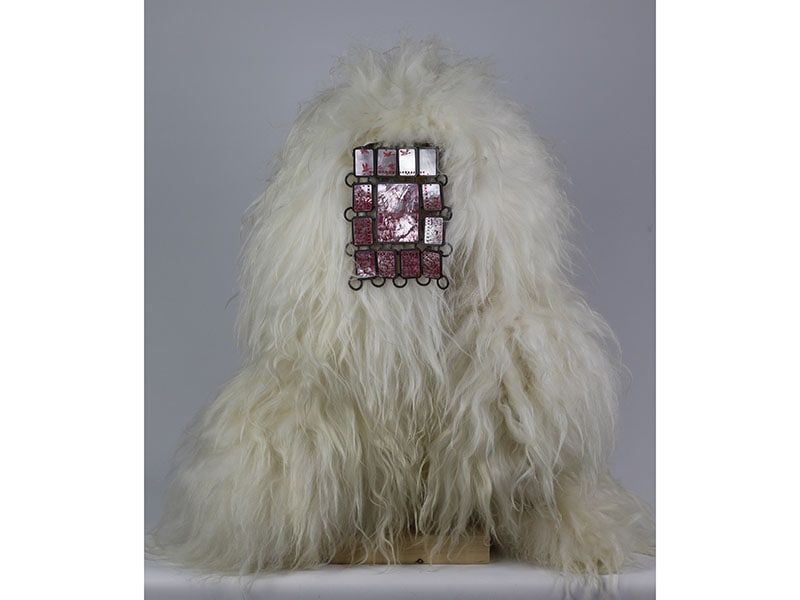
I made these masks as devices to tell my story as a queer artist and to connect to my ancestors in Eastern Europe. I am the character in the story that crafts these entities, an author of sorts. The entities are their own characters as well. Midwinter is a contemplative mask, a face of steel and shell mesh that emulates armor. In this fiction I’ve imagined, her questions are copious and her patience for the answers is like some tireless, plodding draft horse. Engraved on the pearl mesh is a stone wall with a figure behind it hauling a rock. The act of construction or deconstruction is unclear. A flock of geese flies overhead.

What excites you about the art jewelry field?
Margo Csipö: Art jewelry’s only qualifier is that it be wearable (and we can get pretty creative about what is and isn’t wearable). This means there’s a world of possibility with material and interaction with the body.
Something that I truly love about this field are the endless techniques that I can learn and the generosity with which they are taught. I consider myself very lucky to work out of the educational studio space of the Baltimore Jewelry Center, where I’ve learned most of my metalsmithing skills. With each new resident and each seasonal session, there’s some new technique or concept to explore. I’d love to master the craft one day, but the fact that I’ll never be able to learn everything is truly exhilarating!

Where do you think the field is going? What new and exciting trends do you see in art jewelry?
Margo Csipö: I’m kind of an old fogey when it comes to technique, so you won’t hear me lauding things like AI. Good old hand craft will always get me excited in ways an AI-generated image never will.
That aside, I’ve noticed some of my peers starting curatorial and writing practices recently! It’s refreshing that people my age and younger are influencing whose voices are being heard in our field. I can only hope this trend continues, and I’m proud of my friends and peers who are expanding their practices into these disciplines!

Any frustrations that you have with the field or see within it?
Margo Csipö: The financial barrier of entry to studying art jewelry is pretty ridiculous. As an educator, I am always lamenting all the great potential artists we miss because schooling, materials, and space are so expensive. This keeps our field small and full of people from relatively similar backgrounds.
Jewelry is a universal phenomenon across all cultures, and many accessible iterations of it exist, but the academic nature of art jewelry tends to exclude. This is particularly worrisome when admissions are down at most art institutions in the US. This will only serve to make our small field even smaller and less diverse.

If you could write a master plan for your practice, where would you like to be five years from now?
Margo Csipö: In Fall 2025 I’m planning to start grad school, but I’m not even sure where yet. Other than that, I have no concrete plans. I’d love to teach more and get really good at communicating ideas and processes.
As for specific things I’d like to introduce into my practice, I’ve been thinking a lot about:
- Making musical instruments
- Performance-based work
- Garments and fashion
- Larger installation work
- Making my own eyeglass frames
I’m sure I’ll have vastly different ideas about myself and my art even a year from now, and, honestly, thank goodness for that. The foundational theme of my work is seeking understanding, and if I ever find all my answers then I’d have nothing to make art about!
And I’ll continue to apply to things that I think I have no hope of getting and continue to be surprised if I am selected for any of those things—like being an AJF Young Artist Award finalist.
You can purchase work by Margo Csipö at the Baltimore Jewelry Center.
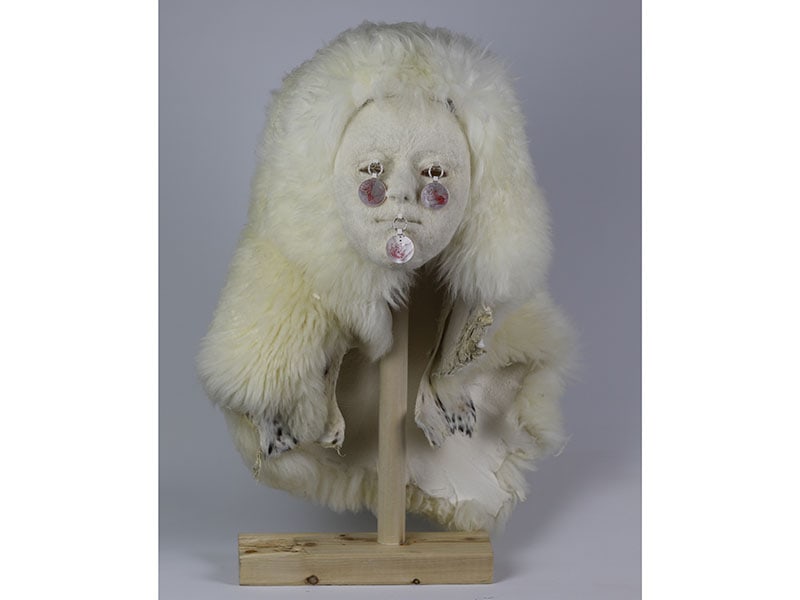
We welcome your comments on our publishing, and will publish letters that engage with our articles in a thoughtful and polite manner. Please submit letters to the editor electronically; do so here.
© 2024 Art Jewelry Forum. All rights reserved. Content may not be reproduced in whole or in part without permission. For reprint permission, contact info (at) artjewelryforum (dot) org




